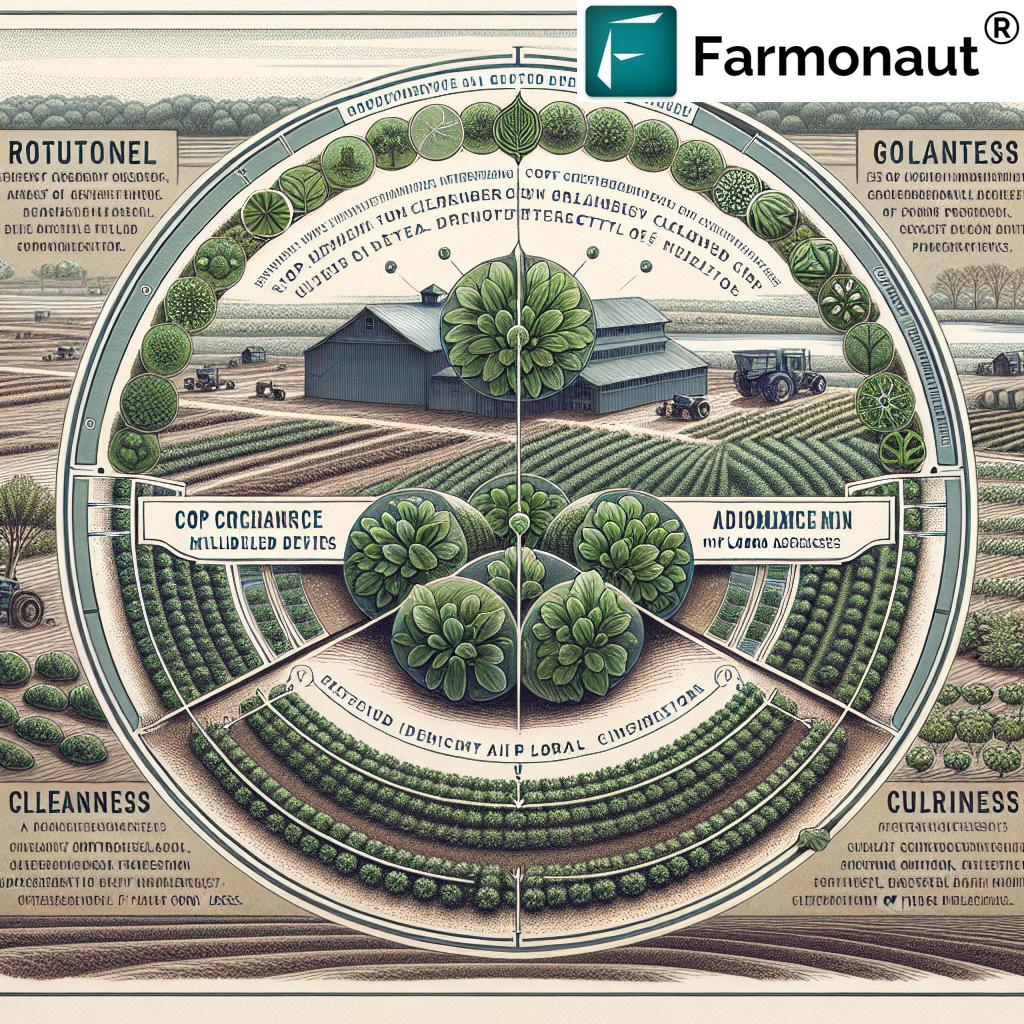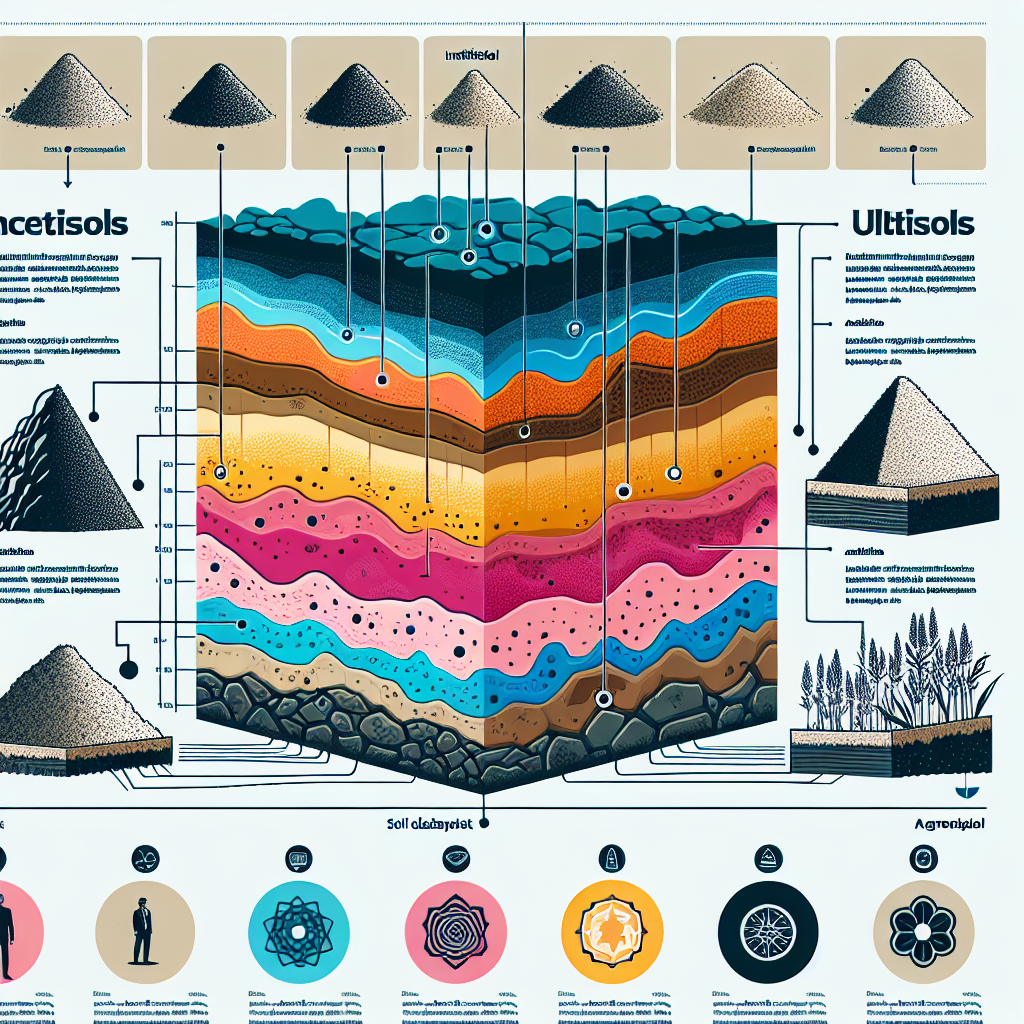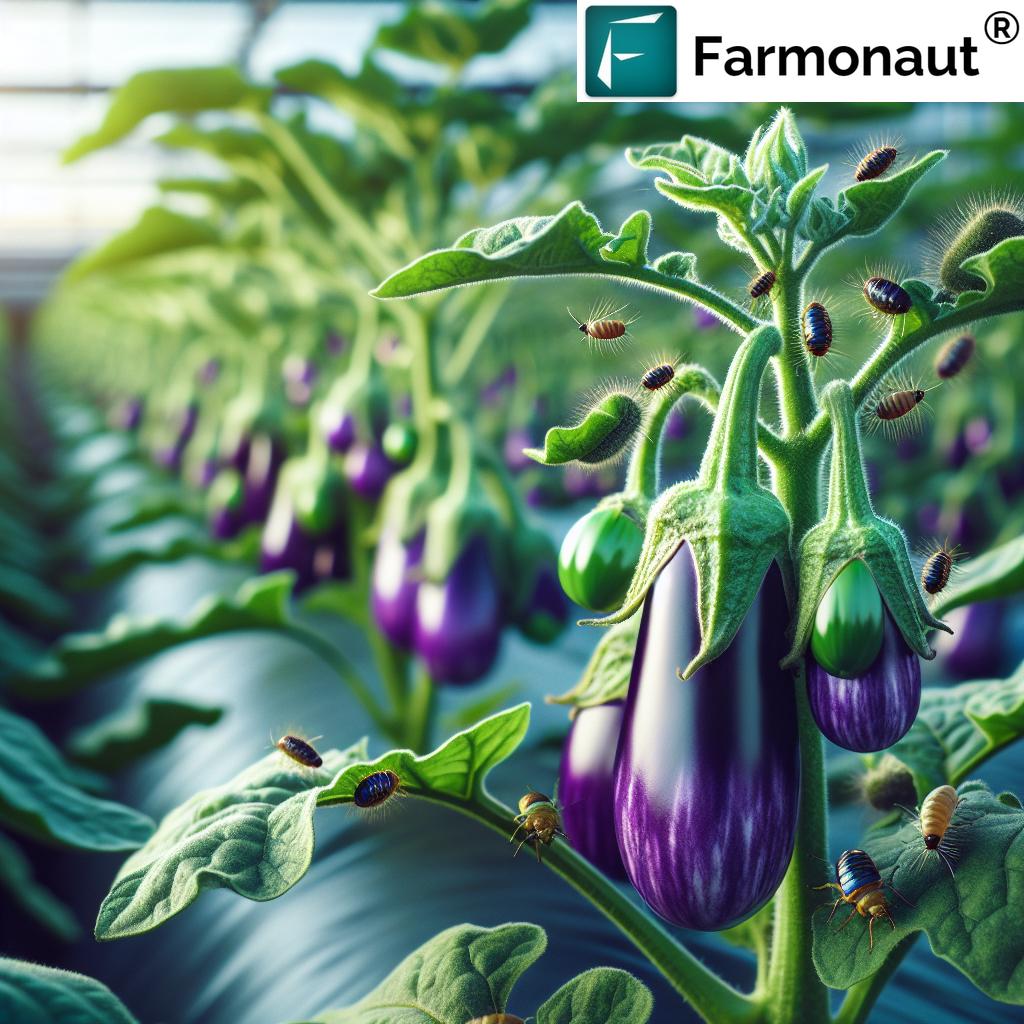How to Prevent Downy Mildew in Crops: Top Tips
“Downy mildew can reduce crop yields by up to 50% if not managed with timely disease control strategies.”
Table of Contents
- Summary: Downy Mildew — An Urgent Crop Threat
- Understanding Downy Mildew
- Recognizing Downy Mildew Symptoms and Its Impact
- Environmental Conditions for Downy Mildew Development
- Comprehensive Downy Mildew Prevention Strategies
- Downy Mildew Prevention Strategies Comparison Table
- Integrated Downy Mildew Management (IDM) Approach
- How Farmonaut Empowers Downy Mildew Control
- Frequently Asked Questions on Downy Mildew
- Conclusion: Implementing Proactive Prevention for Healthier Crops
Summary: Downy Mildew — An Urgent Crop Threat
Downy mildew is a destructive and pervasive plant disease affecting vegetables, fruits, and ornamental plants globally. Caused by various oomycete pathogens, it thrives under specific cool, moist environmental conditions, leading to rapid infection, spread, and potentially devastating yield losses. Timely execution of robust plant disease prevention strategies—rooted in a mix of cultural, biological, and chemical controls—remains crucial to maintain healthy fields and sustainable production.
Key focus keywords: downy mildew, disease, crops, prevention, management, plant, pathogen, infection, symptoms, resistance, prevention strategies, fungicides for downy mildew, environmental conditions for downy mildew, downy mildew control in crops
Understanding Downy Mildew: Biology, Pathogen, and Disease Development
Downy mildew is most commonly caused by oomycete pathogens such as Peronospora, Bremia, Plasmopara, and others. Despite frequent confusion with powdery mildew, downy mildew is a different class of plant disease, characterized by formation of sporangia (producing infective spores) mainly on the undersides of leaves.
Pathogen Biology and Disease Cycle
- Pathogen Class: Oomycetes (water molds) rather than true fungi
- Infection source: Primary infections are typically from overwintered oospores in debris or infected weeds, with secondary spread via airborne sporangia
- Disease progression: Sporangia are produced on infected foliage, especially on leaf undersides during cool, moist conditions. These sporangia germinate and infect new tissues, quickly establishing widespread outbreaks if not controlled with effective prevention strategies
- Critical environmental factors: High humidity (≥90%), cool to moderate temperatures (40–70°F), abundant dew or leaf wetness
Downy mildew pathogens are highly adaptive and can evolve tolerance to chemical controls quickly. Hence, a comprehensive, integrated approach is always needed for sustainable disease management and yield protection.
Recognizing Downy Mildew Symptoms and Its Impact
“Over 30% of downy mildew infections are first identified by yellow leaf spots before visible mold appears.”
Downy Mildew Symptoms: Early Signs and Progression
- Yellowing of leaf tissue: Initial symptoms are often small, irregular or angular yellow spots—usually seen between the veins, especially in crops such as cucurbits and brassicas
- White to grayish fungal growth: Distinctive downy or fuzzy fungal growth on the undersides of affected leaves—key in distinguishing downy mildew from other diseases
- Leaf deformation: Leaves may appear distorted or curled as infection advances
- Premature defoliation: Severe attacks result in extensive leaf drop and exposed plant stems
- Reduced photosynthesis and growth: Chlorosis and necrosis decrease leaf area for photosynthesis, stunting plant development
- Predisposition to secondary infections: Stressed plants become more susceptible to other pathogens and opportunistic infections
Downy mildew symptoms can manifest slightly differently across plant varieties and climates, but the characteristic “downy” sporangial growth under cool, moist conditions is the unifying indicator.
Impact on Yield and Crop Health
- Yield losses: Without robust downy mildew management, yield reductions of 15–50% or greater can be observed in susceptible crops
- Severe outbreaks: Complete crop destruction is possible in vegetables (e.g., cucumbers, squash, lettuce), fruits (grapes, onions), and ornamentals without effective control
- Compromised crop quality: Pre-harvest downy mildew infection drastically reduces marketable quality and increases storage losses
Main Crops Affected:
Downy mildew most commonly targets:
- Vegetables: cucurbits (cucumber, squash, melons), brassicas (cabbage, broccoli), lettuce, spinach, onions
- Fruits: grapes, gooseberries
- Ornamentals: roses, bedding plants, impatiens
Environmental Conditions for Downy Mildew Development
Understanding the environmental conditions for downy mildew is critical to both prevention and timely intervention:
- High relative humidity: >90% humidity greatly increases sporangia production and disease development
- Cool to moderate temperatures: Optimal range: 40°F to 70°F (4°C to 21°C); development slows above 80°F (27°C)
- Frequent leaf wetness: Dew, rain, overhead irrigation prolong wet leaf surfaces—ideal for spore germination and penetration
- Poor air circulation: Dense canopies or closely spaced planting promote microclimates of high humidity and low airflow
- Shaded areas: Limited sun exposure allows leaves to remain wet for longer periods, increasing risk
To break the disease cycle, it’s essential to interrupt these favorable conditions through targeted cultural controls, environmental management, and timely interventions.
Comprehensive Downy Mildew Prevention Strategies
An effective downy mildew management plan spans multiple approaches. Here, we outline the key plant disease prevention strategies, their implementation, and best practices to reduce disease risk and yield losses.
1. Cultural Controls for Downy Mildew
-
Sanitation: Systematically remove and destroy all diseased plant debris, weeds, and crop residues post-harvest.
- This reduces inoculum sources, breaking the local disease cycle and minimizing the potential for initial spring infection.
- Always dispose of infected material away from the cultivation site.
-
Crop rotation: Implement a long-term crop rotation schedule (preferably two or more years) using non-susceptible species.
- This disrupts the buildup of pathogen populations in soil and plant debris via crop rotation disease management.
-
Good planting practices:
- Site crops in areas with maximum sun exposure and good air flow.
- Increase in-row and between-row spacing to promote air movement and quick leaf drying.
- Avoid overhead or late-evening irrigation, as prolonged wet foliage supports infection; use drip irrigation if possible.
- Weed control: Consistently remove weeds and alternate hosts, as many downy mildew pathogens readily overwinter and infect via weed species.
Cultural controls form the basis of preventive disease management and greatly reduce the need for more costly inputs such as fungicides.
2. Biological Control of Plant Diseases
-
Biocontrol agents: Bacillus subtilis, Streptomyces lydicus, and similar beneficial microbes can be applied (usually as sprays or seed treatments) to naturally compete with or suppress downy mildew pathogens.
- Apply preventively when environmental conditions become favorable or at earliest symptom appearance.
- Periodically reapply for lasting protection across growth periods.
- Plant defense stimulation: Use products (biostimulants) designed to trigger plant immune responses, enhancing resistance to infection.
3. Fungicides for Downy Mildew & Chemical Approaches
-
Fungicidal protection: Select and rotate effective fungicides, such as copper-based, mancozeb, chlorothalonil, or newer actives like oxathiapiprolin.
- Apply fungicides preventively or at the earliest sign (early detection of plant diseases is crucial).
- Avoid repeated use of the same mode of action (rotate fungicides) to help prevent resistance.
- Follow all label rates and timing for optimal safety and efficacy.
- Cost and environmental considerations: Over-reliance on fungicides leads to resistance and can harm beneficial microbes; always integrate with other management methods.
4. Resistance and Resistant Varieties
-
Genetic resistance: Choose varieties bred for resistance to the specific downy mildew pathogen strains present in your location (e.g., DM-resistant hybrids of cucumber, spinach, lettuce).
- Although not always absolute, resistant varieties delay or reduce disease severity, lowering reliance on chemical controls.
Rotating resistant crop varieties with other management practices increases their long-term effectiveness in downy mildew control in crops.
5. Environmental Management for Downy Mildew
-
Maintain lower humidity: In greenhouses, keep relative humidity below 85% by using ventilation, heating, or dehumidifiers.
Use our Farmonaut Carbon Footprinting Solution to monitor and minimize the environmental impact of all management interventions. - Improve air circulation: Space plants properly and prune excess foliage to increase airflow and speed up drying.
- Avoid shaded, poorly ventilated areas for crop production.
6. Monitoring, Early Detection and Timely Response
-
Scout fields regularly: Inspect plants weekly (or more often during periods of high risk) for early symptoms and sporangia on leaf undersides.
Utilize digital tools: Farmonaut’s AI-powered crop health monitoring uses satellite-derived NDVI and other indices to flag fields at risk or under early stress, enabling lightning-fast responses to emerging outbreaks.
Discover Farmonaut’s Large-Scale Farm Management Platform for advanced disease surveillance and farm oversight. -
Weather forecasting: Stay aware of upcoming cool and wet periods (ideal for downy mildew development) and schedule management accordingly.
Farmonaut’s Jeevn AI Advisory System provides real-time site-specific forecasts and actionable disease warnings via app, web, or API.
Farmonaut API |
API Developer Docs — Power your systems with satellite weather and disease data. - Keep records: Track weather, outbreaks, and efficacy of different strategies for continuous improvement.
Combining these practices leads to an IDM (integrated disease management) approach—the gold standard for sustainable plant disease prevention and yield maximization.
“Over 30% of downy mildew infections are first identified by yellow leaf spots before visible mold appears.”
Downy Mildew Prevention Strategies Comparison Table
| Prevention Method | Description | Estimated Effectiveness (%) | Cost Level | Application Frequency |
|---|---|---|---|---|
| Crop Rotation | Rotating with non-susceptible crops breaks pathogen cycle and reduces inoculum buildup. | 65–80 | Low | Seasonal/Yearly |
| Resistant Crop Varieties | Using genetically resistant or tolerant varieties to downy mildew for delayed or reduced infection. | 60–90* | Medium | Each Cycle |
| Fungicide Application | Preventive, targeted sprays with rotation of active ingredients (copper, mancozeb, etc.). | 70–95 | Medium–High | Weekly/Biweekly (high risk) |
| Proper Irrigation (Drip/Timing) | Drip or furrow irrigation and watering at sunrise to reduce leaf wetness and humidity. | 40–70 | Low–Medium | Continuous |
| Timely Field Monitoring | Routine scouting for symptoms and rapid response (physical removal, fungicides). | 60–80 | Low | Weekly/Continuous |
| Biological Controls | Application of beneficial microbes (e.g., Bacillus subtilis) that suppress the pathogen. | 50–75 | Medium | Biweekly/Monthly |
| Sanitation & Debris Removal | Routine removal and destruction of infected plant debris and weed hosts. | 60–75 | Low | Seasonal/As Needed |
| Ventilation & Humidity Management | Maintaining relative humidity below 85% in greenhouses, improving air circulation. | 60–85 | Medium | Continuous |
* Effectiveness depends on variety-pathogen compatibility and must be rotated with other strategies for durability.
Integrated Downy Mildew Management (IDM) Approach
No single measure provides complete control of downy mildew. Instead, the IDM approach blends multiple compatible strategies, selected based on local risk factors, crop, season, and available resources.
- Start with prevention: Integrate sanitation, crop rotation, resistant varieties, and optimal air circulation as foundational defenses.
- Monitor and respond: Combine frequent field-checks and digital crop health monitoring with timely targeted chemical or biological controls when needed.
- Fungicides: Use only where justified by disease pressure. Rotate products to avoid resistance.
- Continuous learning: Maintain field records. Review which downy mildew prevention strategies worked well, adapt to new environmental conditions and research-led recommendations.
Through tailored IDM, disease outbreaks can be reduced dramatically, safeguarding farm incomes and crop quality.
How Farmonaut Empowers Downy Mildew Control
As a global leader in satellite-based farm management, Farmonaut provides solutions that fundamentally improve how farmers tackle downy mildew and similar plant diseases:
-
Real-Time Crop Health Monitoring:
- Our platform delivers frequent NDVI, soil moisture, and vegetation index maps direct to farm managers’ phones or browsers. These data pinpoint fields or areas with emerging crop stress, which can signal early infection or poor growth conditions aligning with disease risk.
-
AI-Based Disease Advisories:
-
Our Jeevn AI system combines weather, satellite, and crop data to provide precise, predictive recommendations—such as when humidity and temperature will become conducive for downy mildew outbreaks.
Result: Farmers can initiate scouting and downy mildew control in crops precisely when and where it’s needed, long before major losses arise.
-
Our Jeevn AI system combines weather, satellite, and crop data to provide precise, predictive recommendations—such as when humidity and temperature will become conducive for downy mildew outbreaks.
-
Blockchain-Based Traceability & Resource Optimization:
- Traceability assures buyers and consumers that crops were grown under optimal management, with proof of timely downy mildew prevention strategies and minimal chemical interventions, enhancing market value and trust.
-
Carbon Footprint Tracking:
- Our carbon footprinting tools enable growers to track, benchmark, and minimize emissions even while implementing intensive disease controls—a critical sustainability goal for modern agriculture.
-
Accessible via Mobile, Web, and API:
- Whether you’re an individual farmer, agribusiness, government, or researcher, Farmonaut makes advanced crop health insights easy to access and integrate into daily management.
Make informed, data-driven decisions for every field—download our app, access our browser dashboard, or integrate Farmonaut data with your business via API.
Want to streamline your inputs and decrease losses? Check out Farmonaut’s Fleet Management tools for more effective resource allocation, especially relevant for larger farms practicing intensive downy mildew management.
Enhance plantation and advisory efforts: Try Farmonaut’s Crop Plantation & Forest Advisory suite—tailored for maximizing yield and minimizing disease with actionable, satellite-informed recommendations.
Frequently Asked Questions on Downy Mildew
What is the main difference between downy and powdery mildew?
While both are plant diseases leading to similar symptoms (yellow, deformed leaves, white/gray growth), downy mildew is caused by oomycete pathogens and presents fuzzy growth mainly on the undersides of leaves in cool, wet conditions. In contrast, powdery mildew is true fungi, usually forming powdery spots on both surfaces in dry, warm weather.
What crops are most affected by downy mildew?
Crops most susceptible include cucurbits (cucumber, squash, melon), lettuce, onions, spinach, brassicas (cabbage, broccoli), grapes, and certain ornamentals. Early detection and resistance are key in high-risk crops.
Can downy mildew survive winter?
Yes. Many downy mildew pathogens overwinter as oospores in crop debris, soil, or on infested weeds. Meticulous field sanitation and breaking the disease cycle with crop rotation are crucial.
When is the best time to apply fungicides for downy mildew?
For maximum effectiveness, always apply fungicides preventively—just before or at the very first sign of symptoms, or when environmental conditions favor disease. Rotate active ingredients regularly to avoid resistance and reduce the risk of fungicide failure.
Can weather forecasting help with downy mildew prevention?
Absolutely. Monitoring for cool, moist conditions and prolonged leaf wetness (dew, rain, high humidity) is essential. Weather apps and platforms like Farmonaut’s Jeevn AI Advisory can alert users when to step up field scouting or schedule preventive sprays.
How does Farmonaut help with downy mildew management?
Farmonaut uses satellite imagery, AI-driven health analytics, and weather data to detect plant stress before visible symptoms appear. This enables farmers and advisors to respond with timely scouting and interventions, optimizing resources and minimizing disease impact.
Should I only rely on one method for downy mildew prevention?
No; the most reliable approach is integrated disease management (IDM)—using a combination of prevention, monitoring, cultural controls, fungicide (if needed), resistant varieties, and digital tools to achieve long-term control and sustainability.
Conclusion: Implementing Proactive Prevention for Healthier Crops
Downy mildew will persist as a significant plant health challenge into the future, especially as climate patterns, growing systems, and resistance profiles evolve. However, by understanding the disease’s biology, recognizing key symptoms, and implementing a multi-pronged, comprehensive prevention strategy, farmers and advisors can control infection, reduce yield losses, and maintain vigorous, healthy crops.
The future favours those who act early: Start monitoring conditions daily, adopt powerful farm management tools like Farmonaut, and stay proactive in implementing proven downy mildew controls. With knowledge, vigilance, and the right digital support, crop success is within your grasp—season after season.
Ready to take your disease prevention to the next level?
Try Farmonaut’s leading-edge solutions today—gain peace of mind and the confidence to grow healthier, more resilient crops, whatever conditions arise.
- Learn more about Farmonaut Carbon Footprinting for Sustainable Crop Management
- Explore Farmonaut Product Traceability for transparent supply chains
- Secure farming finances with Farmonaut Crop Loan & Insurance Verification


















